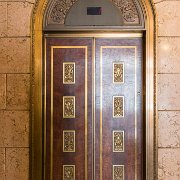
1 Upon its completion the Michigan Theater could seat 4,050 patrons, In addition to films in its prime years, the theatre hosted performances of bands led by John Philip Sousa, Benny Goodman, Jimmy Dorsey and Harry James as well as live performances by The Marx Brothers, Betty Grable and Bob Hope.[4]
The theater ceased operations in 1976 after operating as a nightclub named The Michigan Palace. The office tenants threatened to leave unless they received adequate parking. To retain the tenants, building owners gutted and converted the theater into a parking structure. The theater could not be completely demolished and replaced by a parking structure because it is integral to the structure of the office building. The ornate plaster ceiling of the theater auditorium and grand lobby, at the ninth floor level, are still intact, as are parts of the mezzanine, the 2nd and 3rd balcony foyers and their staircases. The projection booth is also still intact.
The theater ceased operations in 1976 after operating as a nightclub named The Michigan Palace. The office tenants threatened to leave unless they received adequate parking. To retain the tenants, building owners gutted and converted the theater into a parking structure. The theater could not be completely demolished and replaced by a parking structure because it is integral to the structure of the office building. The ornate plaster ceiling of the theater auditorium and grand lobby, at the ninth floor level, are still intact, as are parts of the mezzanine, the 2nd and 3rd balcony foyers and their staircases. The projection booth is also still intact.
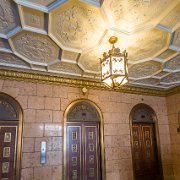
2 Upon its completion the Michigan Theater could seat 4,050 patrons, In addition to films in its prime years, the theatre hosted performances of bands led by John Philip Sousa, Benny Goodman, Jimmy Dorsey and Harry James as well as live performances by The Marx Brothers, Betty Grable and Bob Hope.[4]
The theater ceased operations in 1976 after operating as a nightclub named The Michigan Palace. The office tenants threatened to leave unless they received adequate parking. To retain the tenants, building owners gutted and converted the theater into a parking structure. The theater could not be completely demolished and replaced by a parking structure because it is integral to the structure of the office building. The ornate plaster ceiling of the theater auditorium and grand lobby, at the ninth floor level, are still intact, as are parts of the mezzanine, the 2nd and 3rd balcony foyers and their staircases. The projection booth is also still intact.
The theater ceased operations in 1976 after operating as a nightclub named The Michigan Palace. The office tenants threatened to leave unless they received adequate parking. To retain the tenants, building owners gutted and converted the theater into a parking structure. The theater could not be completely demolished and replaced by a parking structure because it is integral to the structure of the office building. The ornate plaster ceiling of the theater auditorium and grand lobby, at the ninth floor level, are still intact, as are parts of the mezzanine, the 2nd and 3rd balcony foyers and their staircases. The projection booth is also still intact.
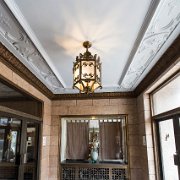
3 Upon its completion the Michigan Theater could seat 4,050 patrons, In addition to films in its prime years, the theatre hosted performances of bands led by John Philip Sousa, Benny Goodman, Jimmy Dorsey and Harry James as well as live performances by The Marx Brothers, Betty Grable and Bob Hope.[4]
The theater ceased operations in 1976 after operating as a nightclub named The Michigan Palace. The office tenants threatened to leave unless they received adequate parking. To retain the tenants, building owners gutted and converted the theater into a parking structure. The theater could not be completely demolished and replaced by a parking structure because it is integral to the structure of the office building. The ornate plaster ceiling of the theater auditorium and grand lobby, at the ninth floor level, are still intact, as are parts of the mezzanine, the 2nd and 3rd balcony foyers and their staircases. The projection booth is also still intact.
The theater ceased operations in 1976 after operating as a nightclub named The Michigan Palace. The office tenants threatened to leave unless they received adequate parking. To retain the tenants, building owners gutted and converted the theater into a parking structure. The theater could not be completely demolished and replaced by a parking structure because it is integral to the structure of the office building. The ornate plaster ceiling of the theater auditorium and grand lobby, at the ninth floor level, are still intact, as are parts of the mezzanine, the 2nd and 3rd balcony foyers and their staircases. The projection booth is also still intact.
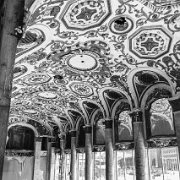
4 Upon its completion the Michigan Theater could seat 4,050 patrons, In addition to films in its prime years, the theatre hosted performances of bands led by John Philip Sousa, Benny Goodman, Jimmy Dorsey and Harry James as well as live performances by The Marx Brothers, Betty Grable and Bob Hope.[4]
The theater ceased operations in 1976 after operating as a nightclub named The Michigan Palace. The office tenants threatened to leave unless they received adequate parking. To retain the tenants, building owners gutted and converted the theater into a parking structure. The theater could not be completely demolished and replaced by a parking structure because it is integral to the structure of the office building. The ornate plaster ceiling of the theater auditorium and grand lobby, at the ninth floor level, are still intact, as are parts of the mezzanine, the 2nd and 3rd balcony foyers and their staircases. The projection booth is also still intact.
The theater ceased operations in 1976 after operating as a nightclub named The Michigan Palace. The office tenants threatened to leave unless they received adequate parking. To retain the tenants, building owners gutted and converted the theater into a parking structure. The theater could not be completely demolished and replaced by a parking structure because it is integral to the structure of the office building. The ornate plaster ceiling of the theater auditorium and grand lobby, at the ninth floor level, are still intact, as are parts of the mezzanine, the 2nd and 3rd balcony foyers and their staircases. The projection booth is also still intact.
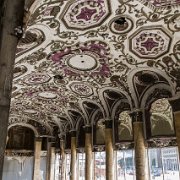
5 Upon its completion the Michigan Theater could seat 4,050 patrons, In addition to films in its prime years, the theatre hosted performances of bands led by John Philip Sousa, Benny Goodman, Jimmy Dorsey and Harry James as well as live performances by The Marx Brothers, Betty Grable and Bob Hope.[4]
The theater ceased operations in 1976 after operating as a nightclub named The Michigan Palace. The office tenants threatened to leave unless they received adequate parking. To retain the tenants, building owners gutted and converted the theater into a parking structure. The theater could not be completely demolished and replaced by a parking structure because it is integral to the structure of the office building. The ornate plaster ceiling of the theater auditorium and grand lobby, at the ninth floor level, are still intact, as are parts of the mezzanine, the 2nd and 3rd balcony foyers and their staircases. The projection booth is also still intact.
The theater ceased operations in 1976 after operating as a nightclub named The Michigan Palace. The office tenants threatened to leave unless they received adequate parking. To retain the tenants, building owners gutted and converted the theater into a parking structure. The theater could not be completely demolished and replaced by a parking structure because it is integral to the structure of the office building. The ornate plaster ceiling of the theater auditorium and grand lobby, at the ninth floor level, are still intact, as are parts of the mezzanine, the 2nd and 3rd balcony foyers and their staircases. The projection booth is also still intact.

6 Upon its completion the Michigan Theater could seat 4,050 patrons, In addition to films in its prime years, the theatre hosted performances of bands led by John Philip Sousa, Benny Goodman, Jimmy Dorsey and Harry James as well as live performances by The Marx Brothers, Betty Grable and Bob Hope.[4]
The theater ceased operations in 1976 after operating as a nightclub named The Michigan Palace. The office tenants threatened to leave unless they received adequate parking. To retain the tenants, building owners gutted and converted the theater into a parking structure. The theater could not be completely demolished and replaced by a parking structure because it is integral to the structure of the office building. The ornate plaster ceiling of the theater auditorium and grand lobby, at the ninth floor level, are still intact, as are parts of the mezzanine, the 2nd and 3rd balcony foyers and their staircases. The projection booth is also still intact.
The theater ceased operations in 1976 after operating as a nightclub named The Michigan Palace. The office tenants threatened to leave unless they received adequate parking. To retain the tenants, building owners gutted and converted the theater into a parking structure. The theater could not be completely demolished and replaced by a parking structure because it is integral to the structure of the office building. The ornate plaster ceiling of the theater auditorium and grand lobby, at the ninth floor level, are still intact, as are parts of the mezzanine, the 2nd and 3rd balcony foyers and their staircases. The projection booth is also still intact.
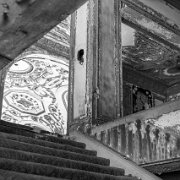
7 Upon its completion the Michigan Theater could seat 4,050 patrons, In addition to films in its prime years, the theatre hosted performances of bands led by John Philip Sousa, Benny Goodman, Jimmy Dorsey and Harry James as well as live performances by The Marx Brothers, Betty Grable and Bob Hope.[4]
The theater ceased operations in 1976 after operating as a nightclub named The Michigan Palace. The office tenants threatened to leave unless they received adequate parking. To retain the tenants, building owners gutted and converted the theater into a parking structure. The theater could not be completely demolished and replaced by a parking structure because it is integral to the structure of the office building. The ornate plaster ceiling of the theater auditorium and grand lobby, at the ninth floor level, are still intact, as are parts of the mezzanine, the 2nd and 3rd balcony foyers and their staircases. The projection booth is also still intact.
The theater ceased operations in 1976 after operating as a nightclub named The Michigan Palace. The office tenants threatened to leave unless they received adequate parking. To retain the tenants, building owners gutted and converted the theater into a parking structure. The theater could not be completely demolished and replaced by a parking structure because it is integral to the structure of the office building. The ornate plaster ceiling of the theater auditorium and grand lobby, at the ninth floor level, are still intact, as are parts of the mezzanine, the 2nd and 3rd balcony foyers and their staircases. The projection booth is also still intact.
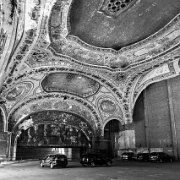
8 Upon its completion the Michigan Theater could seat 4,050 patrons, In addition to films in its prime years, the theatre hosted performances of bands led by John Philip Sousa, Benny Goodman, Jimmy Dorsey and Harry James as well as live performances by The Marx Brothers, Betty Grable and Bob Hope.[4]
The theater ceased operations in 1976 after operating as a nightclub named The Michigan Palace. The office tenants threatened to leave unless they received adequate parking. To retain the tenants, building owners gutted and converted the theater into a parking structure. The theater could not be completely demolished and replaced by a parking structure because it is integral to the structure of the office building. The ornate plaster ceiling of the theater auditorium and grand lobby, at the ninth floor level, are still intact, as are parts of the mezzanine, the 2nd and 3rd balcony foyers and their staircases. The projection booth is also still intact.
The theater ceased operations in 1976 after operating as a nightclub named The Michigan Palace. The office tenants threatened to leave unless they received adequate parking. To retain the tenants, building owners gutted and converted the theater into a parking structure. The theater could not be completely demolished and replaced by a parking structure because it is integral to the structure of the office building. The ornate plaster ceiling of the theater auditorium and grand lobby, at the ninth floor level, are still intact, as are parts of the mezzanine, the 2nd and 3rd balcony foyers and their staircases. The projection booth is also still intact.
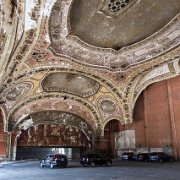
9 Upon its completion the Michigan Theater could seat 4,050 patrons, In addition to films in its prime years, the theatre hosted performances of bands led by John Philip Sousa, Benny Goodman, Jimmy Dorsey and Harry James as well as live performances by The Marx Brothers, Betty Grable and Bob Hope.[4]
The theater ceased operations in 1976 after operating as a nightclub named The Michigan Palace. The office tenants threatened to leave unless they received adequate parking. To retain the tenants, building owners gutted and converted the theater into a parking structure. The theater could not be completely demolished and replaced by a parking structure because it is integral to the structure of the office building. The ornate plaster ceiling of the theater auditorium and grand lobby, at the ninth floor level, are still intact, as are parts of the mezzanine, the 2nd and 3rd balcony foyers and their staircases. The projection booth is also still intact.
The theater ceased operations in 1976 after operating as a nightclub named The Michigan Palace. The office tenants threatened to leave unless they received adequate parking. To retain the tenants, building owners gutted and converted the theater into a parking structure. The theater could not be completely demolished and replaced by a parking structure because it is integral to the structure of the office building. The ornate plaster ceiling of the theater auditorium and grand lobby, at the ninth floor level, are still intact, as are parts of the mezzanine, the 2nd and 3rd balcony foyers and their staircases. The projection booth is also still intact.
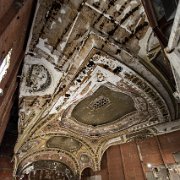
10 Upon its completion the Michigan Theater could seat 4,050 patrons, In addition to films in its prime years, the theatre hosted performances of bands led by John Philip Sousa, Benny Goodman, Jimmy Dorsey and Harry James as well as live performances by The Marx Brothers, Betty Grable and Bob Hope.[4]
The theater ceased operations in 1976 after operating as a nightclub named The Michigan Palace. The office tenants threatened to leave unless they received adequate parking. To retain the tenants, building owners gutted and converted the theater into a parking structure. The theater could not be completely demolished and replaced by a parking structure because it is integral to the structure of the office building. The ornate plaster ceiling of the theater auditorium and grand lobby, at the ninth floor level, are still intact, as are parts of the mezzanine, the 2nd and 3rd balcony foyers and their staircases. The projection booth is also still intact.
The theater ceased operations in 1976 after operating as a nightclub named The Michigan Palace. The office tenants threatened to leave unless they received adequate parking. To retain the tenants, building owners gutted and converted the theater into a parking structure. The theater could not be completely demolished and replaced by a parking structure because it is integral to the structure of the office building. The ornate plaster ceiling of the theater auditorium and grand lobby, at the ninth floor level, are still intact, as are parts of the mezzanine, the 2nd and 3rd balcony foyers and their staircases. The projection booth is also still intact.
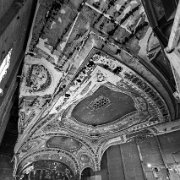
11 Upon its completion the Michigan Theater could seat 4,050 patrons, In addition to films in its prime years, the theatre hosted performances of bands led by John Philip Sousa, Benny Goodman, Jimmy Dorsey and Harry James as well as live performances by The Marx Brothers, Betty Grable and Bob Hope.[4]
The theater ceased operations in 1976 after operating as a nightclub named The Michigan Palace. The office tenants threatened to leave unless they received adequate parking. To retain the tenants, building owners gutted and converted the theater into a parking structure. The theater could not be completely demolished and replaced by a parking structure because it is integral to the structure of the office building. The ornate plaster ceiling of the theater auditorium and grand lobby, at the ninth floor level, are still intact, as are parts of the mezzanine, the 2nd and 3rd balcony foyers and their staircases. The projection booth is also still intact.
The theater ceased operations in 1976 after operating as a nightclub named The Michigan Palace. The office tenants threatened to leave unless they received adequate parking. To retain the tenants, building owners gutted and converted the theater into a parking structure. The theater could not be completely demolished and replaced by a parking structure because it is integral to the structure of the office building. The ornate plaster ceiling of the theater auditorium and grand lobby, at the ninth floor level, are still intact, as are parts of the mezzanine, the 2nd and 3rd balcony foyers and their staircases. The projection booth is also still intact.
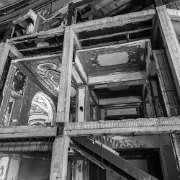
12 Upon its completion the Michigan Theater could seat 4,050 patrons, In addition to films in its prime years, the theatre hosted performances of bands led by John Philip Sousa, Benny Goodman, Jimmy Dorsey and Harry James as well as live performances by The Marx Brothers, Betty Grable and Bob Hope.[4]
The theater ceased operations in 1976 after operating as a nightclub named The Michigan Palace. The office tenants threatened to leave unless they received adequate parking. To retain the tenants, building owners gutted and converted the theater into a parking structure. The theater could not be completely demolished and replaced by a parking structure because it is integral to the structure of the office building. The ornate plaster ceiling of the theater auditorium and grand lobby, at the ninth floor level, are still intact, as are parts of the mezzanine, the 2nd and 3rd balcony foyers and their staircases. The projection booth is also still intact.
The theater ceased operations in 1976 after operating as a nightclub named The Michigan Palace. The office tenants threatened to leave unless they received adequate parking. To retain the tenants, building owners gutted and converted the theater into a parking structure. The theater could not be completely demolished and replaced by a parking structure because it is integral to the structure of the office building. The ornate plaster ceiling of the theater auditorium and grand lobby, at the ninth floor level, are still intact, as are parts of the mezzanine, the 2nd and 3rd balcony foyers and their staircases. The projection booth is also still intact.
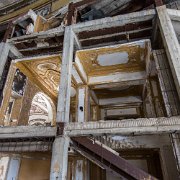
13 Upon its completion the Michigan Theater could seat 4,050 patrons, In addition to films in its prime years, the theatre hosted performances of bands led by John Philip Sousa, Benny Goodman, Jimmy Dorsey and Harry James as well as live performances by The Marx Brothers, Betty Grable and Bob Hope.[4]
The theater ceased operations in 1976 after operating as a nightclub named The Michigan Palace. The office tenants threatened to leave unless they received adequate parking. To retain the tenants, building owners gutted and converted the theater into a parking structure. The theater could not be completely demolished and replaced by a parking structure because it is integral to the structure of the office building. The ornate plaster ceiling of the theater auditorium and grand lobby, at the ninth floor level, are still intact, as are parts of the mezzanine, the 2nd and 3rd balcony foyers and their staircases. The projection booth is also still intact.
The theater ceased operations in 1976 after operating as a nightclub named The Michigan Palace. The office tenants threatened to leave unless they received adequate parking. To retain the tenants, building owners gutted and converted the theater into a parking structure. The theater could not be completely demolished and replaced by a parking structure because it is integral to the structure of the office building. The ornate plaster ceiling of the theater auditorium and grand lobby, at the ninth floor level, are still intact, as are parts of the mezzanine, the 2nd and 3rd balcony foyers and their staircases. The projection booth is also still intact.
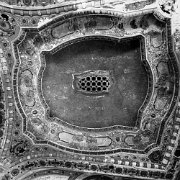
14 Upon its completion the Michigan Theater could seat 4,050 patrons, In addition to films in its prime years, the theatre hosted performances of bands led by John Philip Sousa, Benny Goodman, Jimmy Dorsey and Harry James as well as live performances by The Marx Brothers, Betty Grable and Bob Hope.[4]
The theater ceased operations in 1976 after operating as a nightclub named The Michigan Palace. The office tenants threatened to leave unless they received adequate parking. To retain the tenants, building owners gutted and converted the theater into a parking structure. The theater could not be completely demolished and replaced by a parking structure because it is integral to the structure of the office building. The ornate plaster ceiling of the theater auditorium and grand lobby, at the ninth floor level, are still intact, as are parts of the mezzanine, the 2nd and 3rd balcony foyers and their staircases. The projection booth is also still intact.
The theater ceased operations in 1976 after operating as a nightclub named The Michigan Palace. The office tenants threatened to leave unless they received adequate parking. To retain the tenants, building owners gutted and converted the theater into a parking structure. The theater could not be completely demolished and replaced by a parking structure because it is integral to the structure of the office building. The ornate plaster ceiling of the theater auditorium and grand lobby, at the ninth floor level, are still intact, as are parts of the mezzanine, the 2nd and 3rd balcony foyers and their staircases. The projection booth is also still intact.
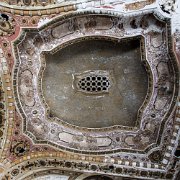
15 Upon its completion the Michigan Theater could seat 4,050 patrons, In addition to films in its prime years, the theatre hosted performances of bands led by John Philip Sousa, Benny Goodman, Jimmy Dorsey and Harry James as well as live performances by The Marx Brothers, Betty Grable and Bob Hope.[4]
The theater ceased operations in 1976 after operating as a nightclub named The Michigan Palace. The office tenants threatened to leave unless they received adequate parking. To retain the tenants, building owners gutted and converted the theater into a parking structure. The theater could not be completely demolished and replaced by a parking structure because it is integral to the structure of the office building. The ornate plaster ceiling of the theater auditorium and grand lobby, at the ninth floor level, are still intact, as are parts of the mezzanine, the 2nd and 3rd balcony foyers and their staircases. The projection booth is also still intact.
The theater ceased operations in 1976 after operating as a nightclub named The Michigan Palace. The office tenants threatened to leave unless they received adequate parking. To retain the tenants, building owners gutted and converted the theater into a parking structure. The theater could not be completely demolished and replaced by a parking structure because it is integral to the structure of the office building. The ornate plaster ceiling of the theater auditorium and grand lobby, at the ninth floor level, are still intact, as are parts of the mezzanine, the 2nd and 3rd balcony foyers and their staircases. The projection booth is also still intact.
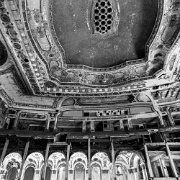
16 Upon its completion the Michigan Theater could seat 4,050 patrons, In addition to films in its prime years, the theatre hosted performances of bands led by John Philip Sousa, Benny Goodman, Jimmy Dorsey and Harry James as well as live performances by The Marx Brothers, Betty Grable and Bob Hope.[4]
The theater ceased operations in 1976 after operating as a nightclub named The Michigan Palace. The office tenants threatened to leave unless they received adequate parking. To retain the tenants, building owners gutted and converted the theater into a parking structure. The theater could not be completely demolished and replaced by a parking structure because it is integral to the structure of the office building. The ornate plaster ceiling of the theater auditorium and grand lobby, at the ninth floor level, are still intact, as are parts of the mezzanine, the 2nd and 3rd balcony foyers and their staircases. The projection booth is also still intact.
The theater ceased operations in 1976 after operating as a nightclub named The Michigan Palace. The office tenants threatened to leave unless they received adequate parking. To retain the tenants, building owners gutted and converted the theater into a parking structure. The theater could not be completely demolished and replaced by a parking structure because it is integral to the structure of the office building. The ornate plaster ceiling of the theater auditorium and grand lobby, at the ninth floor level, are still intact, as are parts of the mezzanine, the 2nd and 3rd balcony foyers and their staircases. The projection booth is also still intact.
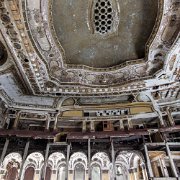
17 Upon its completion the Michigan Theater could seat 4,050 patrons, In addition to films in its prime years, the theatre hosted performances of bands led by John Philip Sousa, Benny Goodman, Jimmy Dorsey and Harry James as well as live performances by The Marx Brothers, Betty Grable and Bob Hope.[4]
The theater ceased operations in 1976 after operating as a nightclub named The Michigan Palace. The office tenants threatened to leave unless they received adequate parking. To retain the tenants, building owners gutted and converted the theater into a parking structure. The theater could not be completely demolished and replaced by a parking structure because it is integral to the structure of the office building. The ornate plaster ceiling of the theater auditorium and grand lobby, at the ninth floor level, are still intact, as are parts of the mezzanine, the 2nd and 3rd balcony foyers and their staircases. The projection booth is also still intact.
The theater ceased operations in 1976 after operating as a nightclub named The Michigan Palace. The office tenants threatened to leave unless they received adequate parking. To retain the tenants, building owners gutted and converted the theater into a parking structure. The theater could not be completely demolished and replaced by a parking structure because it is integral to the structure of the office building. The ornate plaster ceiling of the theater auditorium and grand lobby, at the ninth floor level, are still intact, as are parts of the mezzanine, the 2nd and 3rd balcony foyers and their staircases. The projection booth is also still intact.
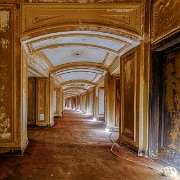
18 It opened August 23, 1926 and was designed by the architectural firm of Rapp & Rapp for Detroit philanthropist and movie theater owner John H. Kunsky. The theater's construction cost $5 million (equivalent to $62 million in 2008). With a seating capacity of 4050, the concert hall/movie house was one of the largest in Michigan. Throughout the 1950s and 1960s, the theater changed ownership several times. It was subsequently used for various events: in the 1960s a closed-circuit television provided views of Red Wings ice hockey games for those who could not attend the actual event in nearby Olympia Stadium, and in the 1970s the theater was a nightclub and concert venue for rock bands.
Upon its completion the Michigan Theater could seat 4,050 patrons, although theatre developer John Kunsky boasted 4,500 seats. In addition to films in its prime years, the theatre hosted performances of bands led by John Philip Sousa, Benny Goodman, Jimmy Dorsey and Harry James as well as live performances by The Marx Brothers, Betty Grable and Bob Hope.
The theater ceased operations in 1976 after operating as a nightclub named The Michigan Palace. After the closure, office tenants threatened to leave unless they received adequate parking. To retain the tenants, building owners gutted and converted the theater into a parking structure. The theater could not be completely demolished and replaced by a parking structure because it is integral to the structure of the office building. The ornate plaster ceiling of the theater auditorium and grand lobby, at the ninth floor level, are still intact, as are parts of the mezzanine, the 2nd and 3rd balcony foyers and their staircases. The projection booth is also still intact. The Michigan Theater was built on the site of the small garage where Henry Ford built his first automobile (the garage was transported brick by brick to The Henry Ford Museum in nearby Dearborn).
The great arched window over the entrance is a false as the grand lobby is approximately 40 feet (12 m) behind the window. This false window (largest of its kind in the country)[citation needed] has a curved back wall with over 50 ornate mirrors that reflected the light from chandelier out to the street. Although the tall narrow chandelier is gone, new lighting has been installed within the 5 story tall window chamber.
The Michigan is featured in several films: in 8 Mile, where the crew rapped before entering the Chin Tiki restaurant space; in The Island, where it is a structure of the Los Angeles of the future; in Street Kings: Motor City; in Alex Cross;[4] and in Transformers: Age of Extinction. Multiple episodes of the television show Detroit 1-8-7 have also filmed scenes in the space. During a scene in Only Lovers Left Alive set in the building, the main protagonists discuss its history as an example of cultural change and decay.
Upon its completion the Michigan Theater could seat 4,050 patrons, although theatre developer John Kunsky boasted 4,500 seats. In addition to films in its prime years, the theatre hosted performances of bands led by John Philip Sousa, Benny Goodman, Jimmy Dorsey and Harry James as well as live performances by The Marx Brothers, Betty Grable and Bob Hope.
The theater ceased operations in 1976 after operating as a nightclub named The Michigan Palace. After the closure, office tenants threatened to leave unless they received adequate parking. To retain the tenants, building owners gutted and converted the theater into a parking structure. The theater could not be completely demolished and replaced by a parking structure because it is integral to the structure of the office building. The ornate plaster ceiling of the theater auditorium and grand lobby, at the ninth floor level, are still intact, as are parts of the mezzanine, the 2nd and 3rd balcony foyers and their staircases. The projection booth is also still intact. The Michigan Theater was built on the site of the small garage where Henry Ford built his first automobile (the garage was transported brick by brick to The Henry Ford Museum in nearby Dearborn).
The great arched window over the entrance is a false as the grand lobby is approximately 40 feet (12 m) behind the window. This false window (largest of its kind in the country)[citation needed] has a curved back wall with over 50 ornate mirrors that reflected the light from chandelier out to the street. Although the tall narrow chandelier is gone, new lighting has been installed within the 5 story tall window chamber.
The Michigan is featured in several films: in 8 Mile, where the crew rapped before entering the Chin Tiki restaurant space; in The Island, where it is a structure of the Los Angeles of the future; in Street Kings: Motor City; in Alex Cross;[4] and in Transformers: Age of Extinction. Multiple episodes of the television show Detroit 1-8-7 have also filmed scenes in the space. During a scene in Only Lovers Left Alive set in the building, the main protagonists discuss its history as an example of cultural change and decay.
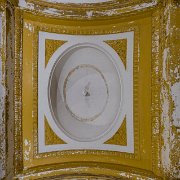
19 It opened August 23, 1926 and was designed by the architectural firm of Rapp & Rapp for Detroit philanthropist and movie theater owner John H. Kunsky. The theater's construction cost $5 million (equivalent to $62 million in 2008). With a seating capacity of 4050, the concert hall/movie house was one of the largest in Michigan. Throughout the 1950s and 1960s, the theater changed ownership several times. It was subsequently used for various events: in the 1960s a closed-circuit television provided views of Red Wings ice hockey games for those who could not attend the actual event in nearby Olympia Stadium, and in the 1970s the theater was a nightclub and concert venue for rock bands.
Upon its completion the Michigan Theater could seat 4,050 patrons, although theatre developer John Kunsky boasted 4,500 seats. In addition to films in its prime years, the theatre hosted performances of bands led by John Philip Sousa, Benny Goodman, Jimmy Dorsey and Harry James as well as live performances by The Marx Brothers, Betty Grable and Bob Hope.
The theater ceased operations in 1976 after operating as a nightclub named The Michigan Palace. After the closure, office tenants threatened to leave unless they received adequate parking. To retain the tenants, building owners gutted and converted the theater into a parking structure. The theater could not be completely demolished and replaced by a parking structure because it is integral to the structure of the office building. The ornate plaster ceiling of the theater auditorium and grand lobby, at the ninth floor level, are still intact, as are parts of the mezzanine, the 2nd and 3rd balcony foyers and their staircases. The projection booth is also still intact. The Michigan Theater was built on the site of the small garage where Henry Ford built his first automobile (the garage was transported brick by brick to The Henry Ford Museum in nearby Dearborn).
The great arched window over the entrance is a false as the grand lobby is approximately 40 feet (12 m) behind the window. This false window (largest of its kind in the country)[citation needed] has a curved back wall with over 50 ornate mirrors that reflected the light from chandelier out to the street. Although the tall narrow chandelier is gone, new lighting has been installed within the 5 story tall window chamber.
The Michigan is featured in several films: in 8 Mile, where the crew rapped before entering the Chin Tiki restaurant space; in The Island, where it is a structure of the Los Angeles of the future; in Street Kings: Motor City; in Alex Cross;[4] and in Transformers: Age of Extinction. Multiple episodes of the television show Detroit 1-8-7 have also filmed scenes in the space. During a scene in Only Lovers Left Alive set in the building, the main protagonists discuss its history as an example of cultural change and decay.
Upon its completion the Michigan Theater could seat 4,050 patrons, although theatre developer John Kunsky boasted 4,500 seats. In addition to films in its prime years, the theatre hosted performances of bands led by John Philip Sousa, Benny Goodman, Jimmy Dorsey and Harry James as well as live performances by The Marx Brothers, Betty Grable and Bob Hope.
The theater ceased operations in 1976 after operating as a nightclub named The Michigan Palace. After the closure, office tenants threatened to leave unless they received adequate parking. To retain the tenants, building owners gutted and converted the theater into a parking structure. The theater could not be completely demolished and replaced by a parking structure because it is integral to the structure of the office building. The ornate plaster ceiling of the theater auditorium and grand lobby, at the ninth floor level, are still intact, as are parts of the mezzanine, the 2nd and 3rd balcony foyers and their staircases. The projection booth is also still intact. The Michigan Theater was built on the site of the small garage where Henry Ford built his first automobile (the garage was transported brick by brick to The Henry Ford Museum in nearby Dearborn).
The great arched window over the entrance is a false as the grand lobby is approximately 40 feet (12 m) behind the window. This false window (largest of its kind in the country)[citation needed] has a curved back wall with over 50 ornate mirrors that reflected the light from chandelier out to the street. Although the tall narrow chandelier is gone, new lighting has been installed within the 5 story tall window chamber.
The Michigan is featured in several films: in 8 Mile, where the crew rapped before entering the Chin Tiki restaurant space; in The Island, where it is a structure of the Los Angeles of the future; in Street Kings: Motor City; in Alex Cross;[4] and in Transformers: Age of Extinction. Multiple episodes of the television show Detroit 1-8-7 have also filmed scenes in the space. During a scene in Only Lovers Left Alive set in the building, the main protagonists discuss its history as an example of cultural change and decay.
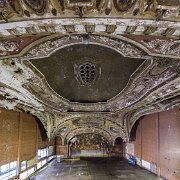
20 It opened August 23, 1926 and was designed by the architectural firm of Rapp & Rapp for Detroit philanthropist and movie theater owner John H. Kunsky. The theater's construction cost $5 million (equivalent to $62 million in 2008). With a seating capacity of 4050, the concert hall/movie house was one of the largest in Michigan. Throughout the 1950s and 1960s, the theater changed ownership several times. It was subsequently used for various events: in the 1960s a closed-circuit television provided views of Red Wings ice hockey games for those who could not attend the actual event in nearby Olympia Stadium, and in the 1970s the theater was a nightclub and concert venue for rock bands.
Upon its completion the Michigan Theater could seat 4,050 patrons, although theatre developer John Kunsky boasted 4,500 seats. In addition to films in its prime years, the theatre hosted performances of bands led by John Philip Sousa, Benny Goodman, Jimmy Dorsey and Harry James as well as live performances by The Marx Brothers, Betty Grable and Bob Hope.
The theater ceased operations in 1976 after operating as a nightclub named The Michigan Palace. After the closure, office tenants threatened to leave unless they received adequate parking. To retain the tenants, building owners gutted and converted the theater into a parking structure. The theater could not be completely demolished and replaced by a parking structure because it is integral to the structure of the office building. The ornate plaster ceiling of the theater auditorium and grand lobby, at the ninth floor level, are still intact, as are parts of the mezzanine, the 2nd and 3rd balcony foyers and their staircases. The projection booth is also still intact. The Michigan Theater was built on the site of the small garage where Henry Ford built his first automobile (the garage was transported brick by brick to The Henry Ford Museum in nearby Dearborn).
The great arched window over the entrance is a false as the grand lobby is approximately 40 feet (12 m) behind the window. This false window (largest of its kind in the country)[citation needed] has a curved back wall with over 50 ornate mirrors that reflected the light from chandelier out to the street. Although the tall narrow chandelier is gone, new lighting has been installed within the 5 story tall window chamber.
The Michigan is featured in several films: in 8 Mile, where the crew rapped before entering the Chin Tiki restaurant space; in The Island, where it is a structure of the Los Angeles of the future; in Street Kings: Motor City; in Alex Cross;[4] and in Transformers: Age of Extinction. Multiple episodes of the television show Detroit 1-8-7 have also filmed scenes in the space. During a scene in Only Lovers Left Alive set in the building, the main protagonists discuss its history as an example of cultural change and decay.
Upon its completion the Michigan Theater could seat 4,050 patrons, although theatre developer John Kunsky boasted 4,500 seats. In addition to films in its prime years, the theatre hosted performances of bands led by John Philip Sousa, Benny Goodman, Jimmy Dorsey and Harry James as well as live performances by The Marx Brothers, Betty Grable and Bob Hope.
The theater ceased operations in 1976 after operating as a nightclub named The Michigan Palace. After the closure, office tenants threatened to leave unless they received adequate parking. To retain the tenants, building owners gutted and converted the theater into a parking structure. The theater could not be completely demolished and replaced by a parking structure because it is integral to the structure of the office building. The ornate plaster ceiling of the theater auditorium and grand lobby, at the ninth floor level, are still intact, as are parts of the mezzanine, the 2nd and 3rd balcony foyers and their staircases. The projection booth is also still intact. The Michigan Theater was built on the site of the small garage where Henry Ford built his first automobile (the garage was transported brick by brick to The Henry Ford Museum in nearby Dearborn).
The great arched window over the entrance is a false as the grand lobby is approximately 40 feet (12 m) behind the window. This false window (largest of its kind in the country)[citation needed] has a curved back wall with over 50 ornate mirrors that reflected the light from chandelier out to the street. Although the tall narrow chandelier is gone, new lighting has been installed within the 5 story tall window chamber.
The Michigan is featured in several films: in 8 Mile, where the crew rapped before entering the Chin Tiki restaurant space; in The Island, where it is a structure of the Los Angeles of the future; in Street Kings: Motor City; in Alex Cross;[4] and in Transformers: Age of Extinction. Multiple episodes of the television show Detroit 1-8-7 have also filmed scenes in the space. During a scene in Only Lovers Left Alive set in the building, the main protagonists discuss its history as an example of cultural change and decay.
Michigan Building